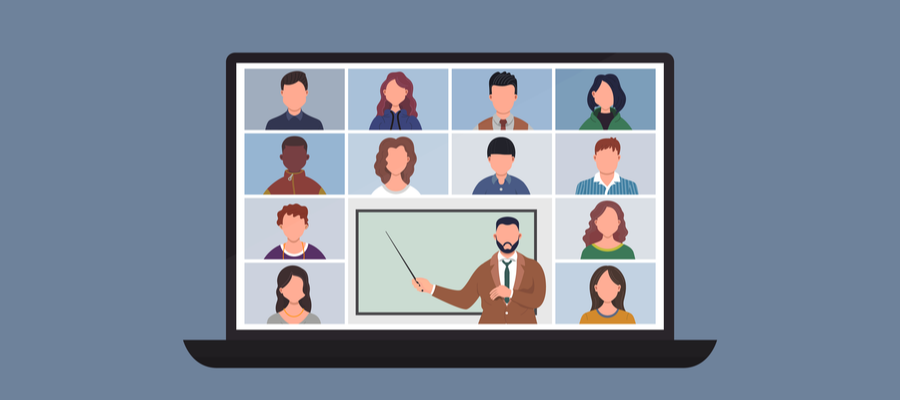You can buy caviar online. With little more know-how than it takes to, say, send an email to a relative across the country, you can purchase ten grams of beluga caviar for a hundred bucks without having to leave your residence—without having to leave your room. Caviar is a delicacy that could once be obtained only through specialty shops or fine-dining establishments. And now, it’s doorstep-delivered in two to three business days! And apparently, the quality’s very respectable. … Blockbuster went out of business in 2010 because it failed to keep up with its emerging competitors like Netflix. Can you remember the last time you rented out a physical, DVD copy of a movie? Yet, statistics demonstrate that more film and television are being consumed today than ever before (Telefilm Canada).
Now, education, too, has migrated to the online environment. But what does it mean to be an online teacher? And how is a virtual classroom different from an in-person classroom? Are online teachers and in-person teachers the same people? Is the caviar still caviar? Online teachers possess specific skills and competencies that allow their knowledge to translate effectively from a physical classroom to a digital one. Though every online teacher harbours different abilities and approaches, there are certain universal techniques that can be used to enhance the online teaching/learning experience.
Here are five things to consider when delivering an online course:
- Synchronous vs. Asynchronous. In a physical classroom context, the material is generally disseminated in what we refer to as a synchronous style. That is, the information is delivered only once, to all students, at the same time. Synchronous lessons are opportunities for students to engage with the material and the instructor in real-time. Dialogues, debates, and discussions are compelling strategies that can be used to enhance learning in a synchronous classroom environment. On the other hand, asynchronous learning refers to material that is placed at the student’s disposal, but that does not depend on the instructor’s intervention or real-time presence. For instance, students asked to listen to a pre-recorded podcast between date x and date y would be involved in asynchronous learning. One style is not superior to the other. In fact, both synchronous and asynchronous material can contribute something unique to the learning experience. Utilizing both strategies in a balanced and deliberate way can elevate the quality of both the content and the learning experience itself.
- Resources and Licenses. There are countless pedagogical tools/instruments that can be used to create a stimulating and interactive learning environment: Zoom, Microsoft Teams, Google Classroom, Slack, or even Facebook are among the most obvious and popular, but they represent only a fraction of what is available to instructors and students. There are tools and software that can be used to facilitate the online teacher’s work: from curriculum design to feedback and grading. It is important that instructors develop a certain level of familiarity with these tools. Once they’ve identified the appropriate ones, instructors should verify that they hold the necessary licenses to ensure that each tool can be used to satisfy its purpose. It is important to note that though multiple tools and software are free and open-ended, some require special licenses and/or subscriptions to access certain functionalities.
- Effective Syllabus and Curriculum Design. With an in-person course that uses a synchronous delivery strategy, teachers can improvise and adapt the material rather easily, without disturbing or compromising the course’s overall structure or objectives. However, a course that is comprised of multiple, pre-determined asynchronous learning materials should be carefully designed so as to be intuitive and easy to navigate. It must account for the absence of live “hand-raising” interjections. Instead, it must be comprehensive so students can be self-sufficient and autonomous. To arrive at a final curriculum that achieves this, it is important for instructors to identify the general learning objectives/key takeaways early in their course development. In so doing, they can reverse engineer the course from its culmination back to its origin and carefully prepare for the implementation of both synchronous and asynchronous material that serves the overall trajectory of the course.
- Student Preparedness and Learning Materials. Another thing that teachers, whether they are first-time or seasoned online instructors, should take into consideration is that online learning and traditional, in-person learning require that students be equipped with different abilities. Typically, an in-person course’s introductory lesson will serve as an orientation session. Students will receive a syllabus, a reading list, and other materials that will prepare them for a particular course. In the same way, online learners must receive the necessary guidance and preparatory details necessary so they can approach the material consciously and without too much uncertainty or hesitation. It is important to acknowledge that multiple students might be new to online learning, and as such, they will not be inherently equipped to engage with digitally delivered learning materials. Small things like developing an FAQ section on your course page or ensuring that you are and remain available to field questions throughout the semester can help to normalize the uncertainty students may feel by encouraging communication and cultivating a dependable, supportive online learning environment.
- Copyright and Fair Dealing. The internet is bottomless. The amount of information and material available online is seemingly unquantifiable. Instructors commonly use the internet to enhance or accompany their own theory. For example, using third-party websites as a complementary learning tool is a common pedagogical practice. Under the Canadian Copyright Act, Fair Dealing “allows the use of material from a copyright-protected work (literature, musical scores, audiovisual works, etc.) without permission when certain conditions are met.” One of these conditions is that the work is used for educational purposes. (Of course, standard citation and referencing guidelines apply.) It is imperative that online instructors have a fundamental understanding of copyright and fair dealing requirements so that they can develop and source their materials accordingly. For further reference on the subject, consult the Concordia University library website.
Online learning has received significant attention and scrutiny as a result of a worldwide migration to remote classrooms provoked by the COVID-19 global pandemic. But online learning was here long before, and it will be here long after. The CBC’s Jessica Wong writes that “Ontario is moving ahead with its plan requiring two online credits for high school graduation. Education Minister Stephen Lecce confirmed this week it will begin this September (March 2021).”
… It looks like it might be time to order that beluga caviar.
Author:
Josh Quirion
Learning Experience Designer @KnowledgeOne |
Writer & Editor-in-Chief at yolkliterary.ca
Josh Quirion is a former journalist and CEGEP instructor. He holds a B.Ed. from Bishop’s University and an M.A. in English Literature and Creative Writing from Concordia University. Quirion published his first book, Towners & Other Stories (Shoreline Press), in 2020.





